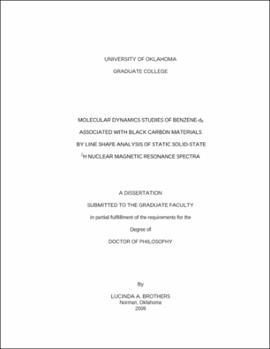| dc.contributor.advisor | Taylor, Richard W | |
| dc.creator | Brothers, Lucinda Ann | |
| dc.date.accessioned | 2019-04-27T21:23:18Z | |
| dc.date.available | 2019-04-27T21:23:18Z | |
| dc.date.issued | 2009 | |
| dc.identifier | 99140878502042 | |
| dc.identifier.uri | https://hdl.handle.net/11244/318551 | |
| dc.description.abstract | Black carbons in the atmosphere, in soils, and in sediments strongly sorb hydrophobic organic contaminants and function as agents of transport, sequestration, and catalysis. There is a need to examine the specific sorption mechanisms involved after attempts to predict field concentrations of these toxic compounds have been in error, and batch isotherm studies did not provide sufficient information. The specific sorption mechanisms, including the influence of the pore characteristics of the solid phase, remain poorly understand. In this study, by using line shape analysis of static solid-state 2H NMR spectra at variable temperatures, ages, and loadings, the molecular motion of benzene-d6 sorbed onto different black carbon materials have been examined for the effects of sorbate-sorbent surface chemical interactions and pore structures. The implications of the sorbent's motional influences on the sorbate are discussed for applications in environmental science, catalysis, and materials chemistry. | |
| dc.description.abstract | The microporosity of the solid phases have been tied to the effects of aging on sorbent behavior implying that microporosity is important for hydrophobic organic contaminant sequestration. The energy of activation of benzene on graphite has been measured at 10.1 (+1.1) kJ/mol, a significantly higher value than previous researchers. Relative to diesel soot, the path of benzene as it diffuses on the surface is controlled by the spherical shape of the grains and pores. The energy of activation on carbon nanoparticles and carbon nanotubes are lower than for planar graphite and is attributed to amorphous chemistry of the carbon nanoparticles and deviation from graphitic planarity in the case of the carbon nanotubes. The materials dominated by microporosity reduce the rate of benzene diffusion and constrain its rotational motion. Finally, the surface diffusivity values, assuming that the benzene molecule moved around the surface of the smallest available pores, were found to correlate with the surface fractal dimension. | |
| dc.format.extent | 327 pages | |
| dc.format.medium | application.pdf | |
| dc.language | en_US | |
| dc.relation.requires | Adobe Acrobat Reader | |
| dc.subject | Soot | |
| dc.subject | Sorbents | |
| dc.subject | Adsorption | |
| dc.subject | Benzene--Adsorption | |
| dc.title | MOLECULAR DYNAMICS STUDIES OF BENZENE-d6 ASSOCIATED WITH BLACK CARBON MATERIALS BY LINE SHAPE ANALYSIS OF STATIC SOLID-STATE 2H NUCLEAR MAGNETIC RESONANCE SPECTRA | |
| dc.type | text | |
| dc.type | document | |
| dc.thesis.degree | Ph.D. | |
| ou.group | College of Arts and Sciences::Department of Chemistry and Biochemistry | |
